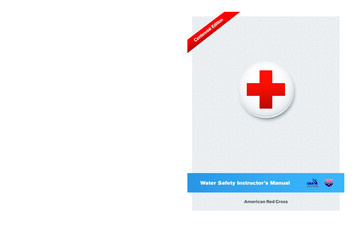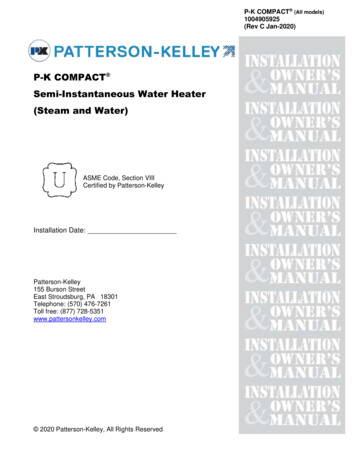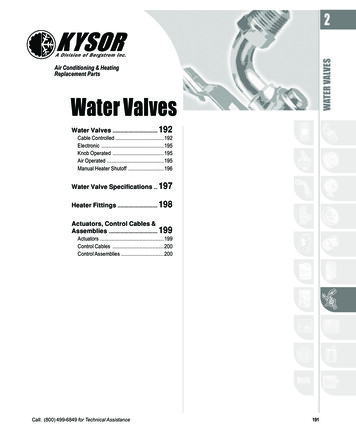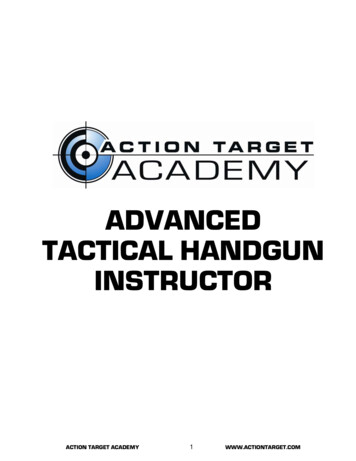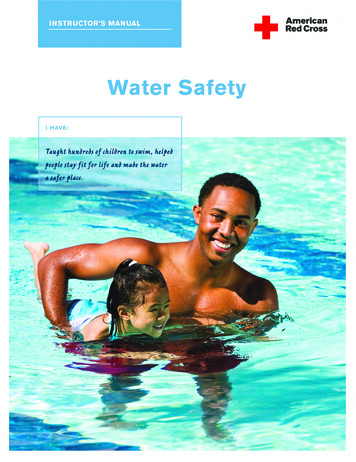
Transcription
Water SafetyInstructor’s Manual
All rights reserved. No part of this publication may be reproduced, stored in a retrieval system, or transmitted in any form or by anymeans, electronic, mechanical, photocopying, recording or otherwise, without prior written permission from American Red CrossNational Headquarters, Preparedness and Health and Safety Services.Copyright 2009, The American National Red Cross.Printed in the United States of AmericaStayWell780 Township Line Rd.Yardley, PA 19067ISBN 978-1-58480-445-110 11 12 13 / 9 8 7 6 5 4 3 2iiWater Safety Instructor’s Manual
AcknowledgmentsThe American Red Cross Swimming and Water Safetyprogram and supporting materials were developedthrough the dedication of both employees andvolunteers. Their commitment to excellence madethis possible.The following Red Cross national headquarters andUSA Swimming staff contributed to the development,design and review of this program and supportingmaterials. The Swimming and Water Safety projectteam included:Jean ErdtmannSenior DirectorProgram Development and Sales SupportPat BoniferDirectorResearch and Product DevelopmentJennifer DeibertProject ManagerProgram Development and Sales SupportMike EspinoProject ManagerResearch and Product DevelopmentFlorence E. FanelliManagerProgram Development and Sales SupportConnie HarveyTechnical ManagerProgram Development and Sales SupportJohn E. HendricksonProject ManagerProgram Development and Sales SupportGreta PetrillaManagerCommunication and MarketingGreg StocktonProject ManagerProgram Development and Sales SupportBobby BroomeSenior AssociateProgram Development and Sales SupportMartha ChapinSenior AssociateProgram Management and Field SupportLindsey DarrahSenior AssociateProduct Management and Business PlanningKelly FischbeinSenior AssociateEvaluationAllanea ForemanSenior AssociateResearch and Product DevelopmentTom HeneghanSenior AssociateProduct Management and Business PlanningDon LauritzenSenior AssociateOperations and Program ManagementLindsay Oaksmith, CHESSenior AssociateProgram Development and Sales SupportJohn ThompsonSenior AssociateOperations and Program ManagementErich EricsonAssociateProgram Development and Sales SupportDenise GonzálezAssociateOperations and Program ManagementBetty J. ButlerAdministrative AssistantOperations and Program ManagementGuidance and support was provided by the followingindividuals:Scott ConnerSenior Vice PresidentPreparedness and Health and Safety ServicesDon VardellNational ChairPreparedness and Health and Safety ServicesThe StayWell team for this edition included:Nancy MonahanSenior Vice PresidentPaula BattExecutive DirectorSales and Business DevelopmentReed KlanderudExecutive DirectorMarketing and New DevelopmentEllen BealEditorial DirectorMary Ellen CurryDirector of Publication ProductionBryan ElrodSenior Developmental EditorShannon BatesSenior Production ManagerKate PlourdeMarketing ManagerAcknowledgmentsiii
The following members of the American Red CrossAdvisory Council on First Aid, Aquatics, Safety andPreparedness (ACFASP) also provided guidanceand review:Dave ThomasSport Development ConsultantUSA SwimmingColorado Springs, ColoradoStephen J. Langendorfer, PhDAssociate Professor, KinesiologySchool of Human Movement, Sport and Leisure StudiesBowling Green State UniversityBowling Green, OhioWendy WestbergHealth and Safety Service ManagerAmerican Red Cross Lower Bucks ChapterLevittown, PennsylvaniaLinda Quan, MDProfessorDepartment of PediatricsUniversity of Washington School of MedicineAttending, Emergency ServicesSeattle Children’s HospitalSeattle, WashingtonThe following individuals provided external guidanceand review:The Sounding Board for this edition included:Patricia L. BennettAquatics CoordinatorDistrict 196 Community EducationRosemount, Apple Valley and Eagan, MinnesotaCatherine L. Bradshaw, CTRSSenior Recreation Supervisor II, Aquatic FitnessInstructorDepartment of Recreation, Parks and Open SpaceTherapeutic Recreation CenterNorfolk, VirginiaSusan T. Dempf, PhDAssociate ProfessorThe School of EducationThe Sage CollegesTroy, New YorkJohn A. KaufmannSupervisor, Training SpecialistUnited States NavyPensacola, FloridaKathy L. RaySafety Outreach SpecialistAmerican Red Cross St. Louis Area ChapterSt. Louis, MissouriivWater Safety Instructor’s ManualJanet GabrielLiaison-Safety, Coach Development and Sports ScienceUSA DivingFort Lauderdale, FloridaRussell MarkBiomechanics ManagerUSA SwimmingColorado Springs, ColoradoLaura MaseCoach (former Education Director)USA SynchroNew Canaan, ConnecticutStefanie Sinno, PhDAssistant Professor of PsychologyMuhlenberg CollegeAllentown, PennsylvaniaJohn A. WaterhouseHenderson, NevadaLeah H. Wright-AnsorgeSpecial Education TeacherMinneapolis, Minnesota
Special AcknowledgmentsThe American Red Cross would like to thank thefollowing individuals who provided talent and locationsfor much of the photography in this manual and the otherproducts supporting this program:Nancy CataldoDirector of Service Center OperationsThe American Red Cross of Central South CarolinaSumter, South CarolinaJay FitzgeraldHead Swim CoachPine Crest Aquatic Center-Woodson PoolFort Lauderdale, FloridaJanet GabrielDive CoachPine Crest Aquatic Center-Woodson PoolFort Lauderdale, FloridaTim GodwinAquatics Supervisor20th Force Support SquadronShaw Air Force Base, South CarolinaPeter KarlAssistant General Manager, AquaticsArmy Navy Country ClubArlington, VirginiaPeggy KubalaAquatics DirectorCity of SumterSumter, South CarolinaMike McGounDirector of Aquatic ServicesCity of Coral SpringsCoral Springs, FloridaBriane SchonfeldtAquatics SupervisorCity of IrvineIrvine, CaliforniaJean SkinnerFairfax County Park AuthorityFairfax, VirginiaAudrey Moore Recreation CenterFairfax County Park AuthorityAnnandale, VirginiaCity of Sumter Aquatics CenterParks and RecreationSumter, South CarolinaCoral Springs Aquatic ComplexCity of Coral SpringsParks and RecreationCoral Springs, FloridaMullins Park PoolCity of Coral SpringsParks and RecreationCoral Springs, FloridaPine Crest Aquatic Center-Woodson PoolPine Crest SchoolFort Lauderdale, FloridaSpring Hill Recreation CenterFairfax County Park AuthorityMcLean, VirginiaUniversity of MarylandCollege Park, MarylandWilliam Woollett Jr. Aquatic CenterCity of IrvineCommunity ServicesIrvine, CaliforniaWoodlands Pool20th Force Support SquadronShaw Air Force Base, South CarolinaSpecial thanks go to the following individuals for theirassistance:Bill Smith DesignInterior DesignerSimon BrutyPhotographerJohn HealyProduction AssistantPhoto LocationsArmy Navy Country ClubArlington, VirginiaAcknowledgmentsv
Water Safety Instructor’s ManualTable of ContentsPart A: AdministrationCHAPTER 5: CUSTOMIzING FORyOUR AUDIENCE 81CHAPTER 1: INTRODUCTION2Program Materials 3Course Participants 6Working with the Local Red Cross ChapterStaffing 6Facilities 8Class Safety 8Acknowledging Course Participation 10Reporting Procedures 11Awarding Certificates 11Course Evaluation 11Red Cross Health and Safety ServicesResources 11Part B: Learning TheoryCharacteristics of Child Learners 82Common Health and Safety Concerns for Infantsand Young Children 89Characteristics of School-Age Children 90Characteristics of Adult Learners 91Techniques to Enhance Adult Learning 94Adjusting the Learning Environment forAdults 9516CHAPTER 6: CUSTOMIzINGFOR INDIVIDUALS WITHDISABILITIES AND OTHERHEALTH CONDITIONS 98Teaching Swimming to Individuals withDisabilities 99Assessing Participant Needs 99Techniques to Enhance Learning 102Modifications 111Exploring Alternative Programs 11213CHAPTER 2: TEACHING ANDLEARNING SWIMMING 14Developmental Principles of Learning MotorSkills 15Motor Learning Principles 17Using Teaching Progressions 19Teaching Principles 24Part D: The CoursesCHAPTER 7: PARENT AND CHILDAQUATICS 114Part C: Course Planningand Management 31CHAPTER 3: COURSE PLANNING32Planning a Session 33Principles of Class Organization 40Holding and Support Techniques 44Flotation Devices and Teaching Aids Used in RedCross Programs 50CHAPTER 4: INTEGRATING WATERSAFETy INTO THE COURSES 56Putting Water Safety into Practice 57Water Safety as Part of Learning to SwimSafety Equipment During Lessons 59Keep Water Safety Active 59Key Water Safety Topics 60viWater Safety Instructor’s Manual57113Administrative Notes 115Safety Considerations 117Teaching Young Children 118The Parent and Child Aquatics CourseOutlines 119Parent and Child Aquatics Level 1 122Parent and Child Aquatics Level 1 SkillsParent and Child Aquatics Level 2 133Parent and Child Aquatics Level 2 SkillsCHAPTER 8: PRESCHOOLAQUATICS 147Administrative Notes 148Safety Considerations 150Teaching Preschool Children 151The Preschool Aquatics Outlines 153Preschool Aquatics Level 1 154Preschool Aquatics Level 1 Skills 156Preschool Aquatics Level 2 165Preschool Aquatics Level 2 Skills 167Preschool Aquatics Level 3 171Preschool Aquatics Level 3 Skills 173124135
CHAPTER 9: LEARN-TO-SWIM177Administrative Notes 178Applying Techniques for Teaching Learn-to-Swimto Different Ages 180The Learn-to-Swim Outlines 181Learn-to-Swim Level 1—Introduction to WaterSkills 182Learn-to-Swim Level 1 Skills 184Learn-to-Swim Level 2—Fundamental AquaticSkills 188Learn-to-Swim Level 2 Skills 190Learn-to-Swim Level 3—Stroke Development 194Learn-to-Swim Level 3 Skills 196Learn-to-Swim Level 4—Stroke Improvement 206Learn-to-Swim Level 4 Skills 208Learn-to-Swim Level 5—Stroke Refinement 220Learn-to-Swim Level 5 Skills 222Learn-to-Swim Level 6—Swimming and SkillProficiency 229Learn-to-Swim Level 6—Personal Water SafetySkills 231Learn-to-Swim Level 6—Fundamentals ofDiving 236Learn-to-Swim Level 6—Fundamentals of DivingSkills 239Learn-to-Swim Level 6—Fitness Swimmer 250Learn-to-Swim Level 6—Fitness SwimmerSkills 252Part E: Teaching Water Safety257CHAPTER 10: WATER SAFETyCOURSES AND PRESENTATIONS258Basic Water Rescue 259Safety Training for Swim Coaches 259Water Safety Today 259Personal Water Safety 260General Water Safety 260Home Pool Safety 260Parent Orientation to Swim Lessons 260Sun Safety 260Rip Current Safety 261Longfellow’s WHALE Tales 261SOURCES262Table of Contentsvii
Par t AAdministration
CHAPTER1IntroductionThe purpose of the American Red Cross Swimming and Water Safetyprogram is to teach people how to be safe in, on or around water and toteach individuals of different ages and abilities how to swim. Programming forpeople with special needs, such as those with disabilities, and different skilllevels is a key component. In a logical progression, the program covers theknowledge and skills needed for aquatic skill development. As participantsdevelop these skills, they will become safer and better swimmers.
11Before you teach any of these courses orpresentations, you should be familiar with theAmerican Red Cross Swimming and Water Safetymanual, the Water Safety Instructor’s CD-ROM, thisinstructor’s manual and the following additionalmaterials and resources:nnnInstructors intending to teach water safetycourses and presentations must use the leader’sguides provided on Instructor’s Corner(www.instructorscorner.org).Instructors who wish to teach Longfellow’sWHALE Tales must use the Longfellow’sWHALE Tales K–6 Educational Packet. Anoptional Longfellow’s WHALE Tales DVD alsois available.Instructors intending to teach the Safety Trainingfor Swim Coaches course must also use theAmerican Red Cross Safety Training for Swim CoachesSupplement and American Red Cross Safety Trainingfor Swim Coaches Instructor’s Manual. This instructor’s manual is the primary resourcethat explains and describes the Red CrossSwimming and Water Safety program. Themanual will direct you to the appropriateresource, the accompanying CD-ROM and toInstructor’s Corner (www.instructorscorner.org)for course materials. This manual suggeststeaching concepts, strategies, best practicesteps and progressions, along with tips toensure participant’s success. It includes detailedinformation for instructors to plan, prepare andteach the Red Cross Swimming and Water Safetyprogram. The instructor’s manual has six parts:nProgram MaterialsSwimming and Water Safety program materialsare available from your local Red Cross chapter.Contact your chapter to purchase any materialsnecessary when teaching your class. Materials alsocan be purchased on Instructor’s Corner(www.instructorscorner.org) or www.shopstaywell.com.nnWater Safety Instructor’s Manualand CD-ROMThis manual and CD-ROM are resources forthose authorized by the Red Cross as WaterSafety instructors to teach the following RedCross Swimming and Water Safety coursesand presentations:nParent and Child AquaticsnPreschool AquaticsnLearn-to-SwimnBasic Water RescuenPersonal Water SafetynWater Safety Presentations Water Safety Today General Water Safety Home Pool SafetyParent Orientation to Swim LessonsSun SafetyRip Current SafetynnPart A: Administration. Introduces theSwimming and Water Safety program, describescourse organization and course completionprocedures and discusses class safety andinstructor responsibilities.Part B: Learning Theory. Builds oninformation learned in the Fundamentals ofInstructor Training course regarding the teachingand learning process, including the principles ofmotor learning. It contains some strategies andsuggestions to use when teaching your courses.Part C: Course Planning andManagement. Explains how to prepare blockplans and lesson plans, as well as how to organizecourses. It explains how to integrate water safetyknowledge and skills into classes and presentsconcepts for planning how to teach differentages and abilities. It also explains the importanceof communication with parents, includingeffective use of the Learn-to-Swim booklets inworking with children. Additionally, this sectiondiscusses issues that affect young learners andtheir parents.Part D: The Courses. Details each of the levelsof Parent and Child Aquatics, Preschool Aquaticsand Learn-to-Swim. For each level, it explainslearning objectives, defines readiness for the level,provides an outline of skills and details skill stepsand progressions.Part E: Teaching Water Safety. Describesthe Water Safety courses and presentationsIntroduction3
available in the Swimming and Water Safetyprogram. It directs you to the appropriateresources for specific lesson plans and participantmaterials. It also identifies target audiences andprovides suggestions for offering the courses andpresentations in the community.The accompanying CD-ROM is a valuableresource for instructors as well as a greatresource for program coordinators. Forinstructors, it contains information andresources to help them plan and prepareto teach. The CD-ROM includes—nSample block plans and lesson plans foreach level.nTeaching activities, games and drills.nSample forms, such as skill checklists.nNewsletters for each level.nCertificates of achievement for each level.For program coordinators, the CD-ROMprovides tools to assist in managing a swimmingand water safety program and a team ofinstructors, including—nSample instructor evaluation forms.nSample job description.nnnSample records and reports, such as performancereports and registration forms.Instructor recruitment information.Information about managing and promoting RedCross Swimming and Water Safety programs.Swimming and Water SafetyThe basic resource for instructors is the AmericanRed Cross Swimming and Water Safety manual.The manual, combined with the American RedCross Swimming and Diving Skills DVD, is also aresource for participants in Learn-to-Swim Levels5 and 6 and adults who are interested in learningto swim, refining their strokes or learning moreabout aquatics. Swimming and Water Safety isrequired for participants in the Safety Training forSwim Coaches course. The manual describes andillustrates the skills in the Swimming and WaterSafety program.Swimming and Water Safety provides informationregarding the components of aquatic safety as well4Water Safety Instructor’s Manualas skill analysis for basic aquatic skills, strokes,diving and competitive swimming. This manualalso presents more information for instructorsteaching swimmers with disabilities or whowant to incorporate more fitness activities intotheir teaching.Water Safety HandbookThe American Red Cross Water Safety Handbook isused to support the water safety presentationson Instructor’s Corner (www.instructorscorner.org).It is designed to increase safety wherever andwhenever water sports are enjoyed. It includeseasy-to-remember safety tips for pools, spas,waterparks, lakes, rivers, oceans and more. Thehandbook is ideal for parents, the general public,youth in grades 4–12 or youth organizations, andpeople who participate in activities in and aroundthe water, such as camp staff and campers.Raffy Learns to Swim and Waddlesin the DeepTwo booklets are integral to Red Cross PreschoolAquatics and Learn-to-Swim lessons—Raffy Learnsto Swim and Waddles in the Deep. These bookletsprovide a written communication mechanismbetween instructors and parents and participants,and they reinforce the content learned duringthe lessons.Raffy Learns to Swim contains—nnnnnA story line that supports and reinforces whatparticipants are learning.Achievement cards that indicate a participant’sprogress toward passing Red Cross PreschoolAquatics Levels 1 and 2 and Learn-to-SwimLevel 1. The instructor completes the appropriateachievement card at the end of each session.Activities to help parents practice with their child.General water safety tips to help parents keeptheir family safe whenever they are in, on oraround water.A chart that provides an overview of Red CrossPreschool Aquatics and Learn-to-Swim.Waddles in the Deep contains—nA story line that supports and reinforces whatparticipants are learning.
1nnnnAchievement cards that indicate the participant’sprogress toward passing Red Cross PreschoolAquatics Level 3 and Learn-to-Swim Levels 2and 3. The instructor completes the appropriateachievement card at the end of each session.Activities to help parents practice with their child.Tips for safe diving to help keep parents andtheir family safe from injuries to the head, neckand back.A chart that provides an overview of Red CrossPreschool Aquatics and Learn-to-Swim.Longfellow’s WHALE Tales K–6Educational Packet and Longfellow’sWHALE Tales DVDLongfellow’s WHALE Tales targets childrenages 5–12 and teaches safe behavior in, on andaround the water. The materials in the Longfellow’sWHALE Tales K–6 Educational Packet are designedto give children an awareness of being safearound the water and to help promote healthfulaquatic recreation.Longfellow’s WHALE Tales is designed to beflexible to meet the needs of the participants.Leaders can pick or choose activities from 11safety topics when developing a presentation.There is no set format and no minimum ormaximum time requirements for presenting theinformation. An optional DVD is available.your local Red Cross chapter and on the Healthand Safety Services section of the Red Cross Website at www.redcross.org. Instructors use the SafetyTraining for Swim Coaches Instructor’s Manual to teachthe course, which is also available in an electronicformat from your local Red Cross chapter.DVDsThe DVDs, which are required for the WaterSafety Instructor course, may also be used asteaching aids for the Swimming and Water Safetyprogram. The following three DVDs are part ofthe Swimming and Water Safety Program DVD Set:nnnSafety Training for Swim Coaches, developed incollaboration with USA Swimming, is designedto provide participants training in aquatic safetythat focuses on basic knowledge and skills toprevent and respond appropriately to many ofthe emergencies that can occur in a competitiveswimming environment.The Safety Training for Swim Coaches course hasseveral delivery options that fit individuals’ needsand provide flexibility in making it easy to attainand maintain this important certification. Participantmaterials include Swimming and Water Safety andthe Safety Training for Swim Coaches Supplement. Thesupplement is available in electronic format fromAmerican Red Cross Teaching Swimming andWater SafetyAmerican Red Cross Longfellow’s WHALE TalesInstructor’s CornerInstructor’s Corner is a Web site(www.instructorscorner.org) dedicated to Red Crossinstructors. It contains additional informationdesigned to help you as an instructor, includingfrequently asked questions, instructor updates,program updates and course-related forms. Inaddition, lesson plans for the following watersafety courses and presentations also are onInstructor’s Corner:nnSafety Training for Swim CoachesSupplement and Safety Training forCoaches Instructor’s ManualAmerican Red Cross Swimming and Diving SkillsnBasic Water RescuePersonal Water SafetyWater Safety Presentations Water Safety Today General Water Safety Home Pool Safety Parent Orientation to Swim Lessons Sun Safety Rip Current SafetyAdditional Instructor ResourcesDepending on the courses you teach, you mayfind it useful to consult the following materials:nnnAmerican Red Cross Fundamentals of InstructorTraining Participant’s ManualAmerican Red Cross LifeguardingAmerican Red Cross Lifeguarding Instructor’s Manualwith CD-ROMIntroduction5
nnnnAmerican Red Cross Lifeguarding DVDAmerican Red Cross Lifeguard ManagementAmerican Red Cross Basic Water RescueAmerican Red Cross Small Craft SafetyCourse ParticipantsThe Red Cross has developed age guidelines forthe Swimming and Water Safety courses. Therecommended ages are only general guidelines.For children, take into consideration readiness,experience and maturity level when determiningthe course level in which participantsshould enroll.nnnnParent and Child Aquatics is intended forinfants and toddlers from 6 months to about3 years of age.Preschool Aquatics is intended for children about4 and 5 years of age.Learn-to-Swim is intended for children fromabout 6 years of age through older adults. Learnto-Swim courses can be customized for differentages and abilities. Generally, classes should haveparticipants of similar ages and abilities so youcan conduct appropriate activities. Participantsshould also have the knowledge, skills andreadiness appropriate for each level. For moreinformation on these topics, see the individualLevel Notes sections.For most water safety courses and presentations,there are no age prerequisites to participate.However, courses and presentations should haveparticipants of similar ages and abilities so youcan conduct appropriate activities. Also, somecourses and presentations are more suited toolder audiences. For more information on thesetopics, see the individual Course or PresentationNotes section.Working with the Local RedCross ChapterIf you wish to teach any part of the Swimming andWater Safety program, you should start planningwell before the first class begins. Meet with yourlocal Red Cross chapter. The chapter will assistyou with—nnYour authorization to teach.The Instructor Agreement and, if applicable, theAuthorized Provider Agreement6Water Safety Instructor’s ManualnLocal policies and procedures, in addition tonational guidelines.The chapter may want to know the dates, timesand locations of the course(s). Contact your localRed Cross chapter for any other informationyou need before your first lesson and any timethereafter if you have questions. The instructor’sCD-ROM and Instructor’s Corner (www.instructorscorner.org) are valuable resources to helpyou plan and teach any courses or presentations inthe Swimming and Water Safety program.StaffingWater Safety InstructorsYour responsibilities as a Red Cross Water Safetyinstructor include—nnnnnnnnnnEnsuring that all participants have the physicalability to perform the skills and know to consultyou if they have concerns about their physicalability to do so.Ensuring the classroom, pool and all practiceareas are free of hazards.Administering and scoring the finalwritten exam(s).Being familiar with and knowing how touse course materials and trainingequipment effectively.Planning, coordinating and managing trainingwith your local Red Cross chapter, includingadvising the local Red Cross chapter in advanceof any classes you are scheduled to teach.Informing participants about knowledge andskill evaluation procedures and coursecompletion requirements.Creating a non-threatening environment that isconducive to achieving the learning objectives.Preparing participants to meet thecourse objectives.Adapting your teaching approach to matchthe experience and abilities of the participants,identifying participants who are having difficultyand developing effective strategies to help themmeet course objectives.Supervising participants while they are practicingcourse skills and providing timely, positive andcorrective feedback as they learn.
1nnnnnnnnnnnEvaluating participants as they perform skills,focusing on critical performance steps asdescribed in the skill sheets and/or outlines.Conducting courses in a manner consistent withcourse design.Issuing course completion certificates.Submitting completed course records and reportsto the Red Cross representative within 10 workingdays from course completion.Being familiar with and informing participants ofother Red Cross courses and programs.Being prepared to answer participants’ questionsor knowing where to find the answers.Providing a positive example by being neatin appearance and not practicing unhealthybehaviors, such as smoking, while conductingRed Cross courses.Identifying potential instructor and instructor aidecandidates and referring them to the appropriateRed Cross representatives.Abiding by the obligations in the InstructorAgreement and Code of Conduct and, if applicable,the Authorized Provider Agreement.Representing the Red Cross in a positive manner.Promoting volunteer opportunities availablethrough the Red Cross.The Red Cross also recommends the followingminimum instructor-to-participant ratios:nnnParent and Child Aquatics: 1 instructor for every10 parent and child pairsPreschool Aquatics levels 1 through 3 and Learnto-Swim levels 1 through 3: at least 1 instructorfor every 6 participantsLearn-to-Swim levels 4 through 6 and BasicWater Rescue: at least 1 instructor for every 10participantsClose supervision is necessary to make practiceeffective and the class safe. To increase safetyand instructional quality, consider having fewerparticipants per instructor.Co-Instructors and Instructor AidesUsing co-instructors is an effective way toincrease the amount of individual attention eachparticipant receives. Co-instructors should becertified and authorized Water Safety instructors.Inexperienced Water Safety instructors andseasoned instructors can be paired to provideadditional instructional attention for participantswhile at the same time helping the new instructorgain experience and confidence.Water Safety instructor aides can assist WaterSafety instructors with clerical, supervisory andmaintenance responsibilities. Instructor aidesmust work under the direct supervision of a WaterSafety instructor who is actively teaching thecourse. Effective use of aides allows the instructorto focus more time on the instructional aspects ofthe classes. Water Safety instructor aides shouldbe able to—nnnDemonstrate the skills being taught.Assist participants under the direction of theWater Safety instructor.Recognize unsafe conditions and behaviorsand respond either by addressing or reportingsituations to the instructor or swimming and watersafety program coordinator.It is important when using additional staff, suchas co-instructors and instructor aides, to definetheir roles and responsibilities clearly. This helpseliminate confusion and lapses in supervision.Remember, you are ultimately responsible foryour participants’ safety.To find candidates for Water Safety instructoraides, consider individuals who exhibit a strongsense of maturity and responsibility. Water Safetyinstructor aides must have successfully completedthe level or demonstrated the knowledge andskills for the level for which they are servingas an aide. Water Safety instructors or WaterSafety instructor trainers can train instructoraides. Follow the American Red Cross Manual ofAdministrative Policies and Procedures (MAPP) forselecting and training instructor aides. MAPPcan be found on the Instructor Tools section ofInstructor’s Corner (www.instructorscorner.org).LifeguardsAn adequate number of lifeguards should be onduty and conducting patron surveillance during allin-water sessions. Having lifeguards on duty—nImproves the instruction by letting youconcentrate on teaching.Introduction7
nnIncreases the safety of participants.Provides trained rescuers who can take action inan emergency.FacilitiesTo ensure that your course is safe and successful,be sure your swimming facility has the appropriatedimensions. You need to consider the typesof classes and the ages of the participants. Forexample, course requirements may need to bemodified when the water is too deep for participantsto stand or if the water is not deep enough for safediving when performing headfirst entries (headfirstentries should not be taught when the water isless than 9 feet deep). If you use a waterfrontfacility, it should be free of surf and large enoughto practice skills. It should have a clearly marked,safe swimming area that is large enough and deepenough for your program. Courses for infants,toddlers and preschoolers should not be conductedin untreated water, which is more likely to carryharmful organisms than sanitized pools. If you areunsure whether your swimming area is appropriate,check local and state regulations or with the healthdepartment. Contact your local Red Cross chapteror post a question in the forum on Instructor’sCorner (www.instructorscorner.org) and check thefrequently asked questions for accurate informationbefore offering courses.Water temperature also may be a key issuefor your program. According to the AquaticExercise Association (AEA), a comf
The American Red Cross Swimming and Water Safety program and supporting materials were developed through the dedication of both employees and volunteers. Their commitment to excellence made this possible. The following Red Cross national headquarte
